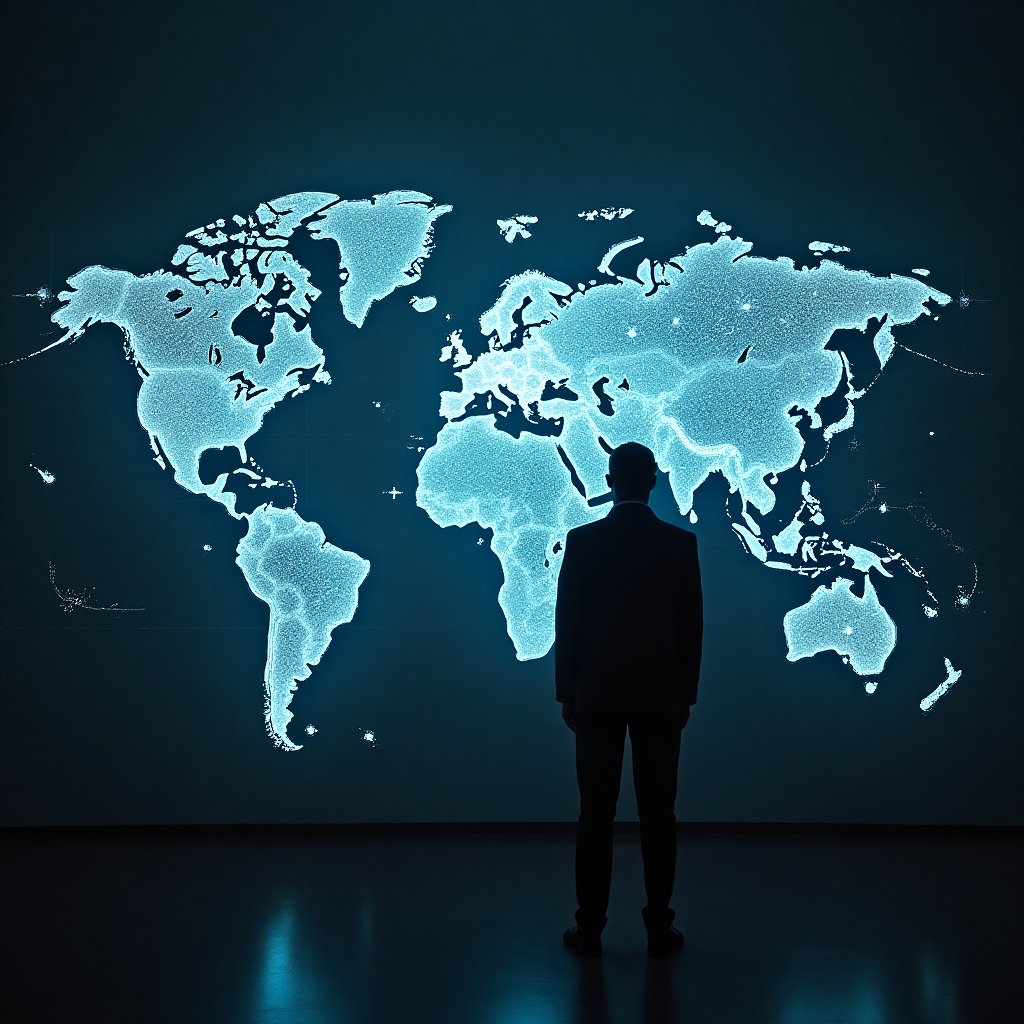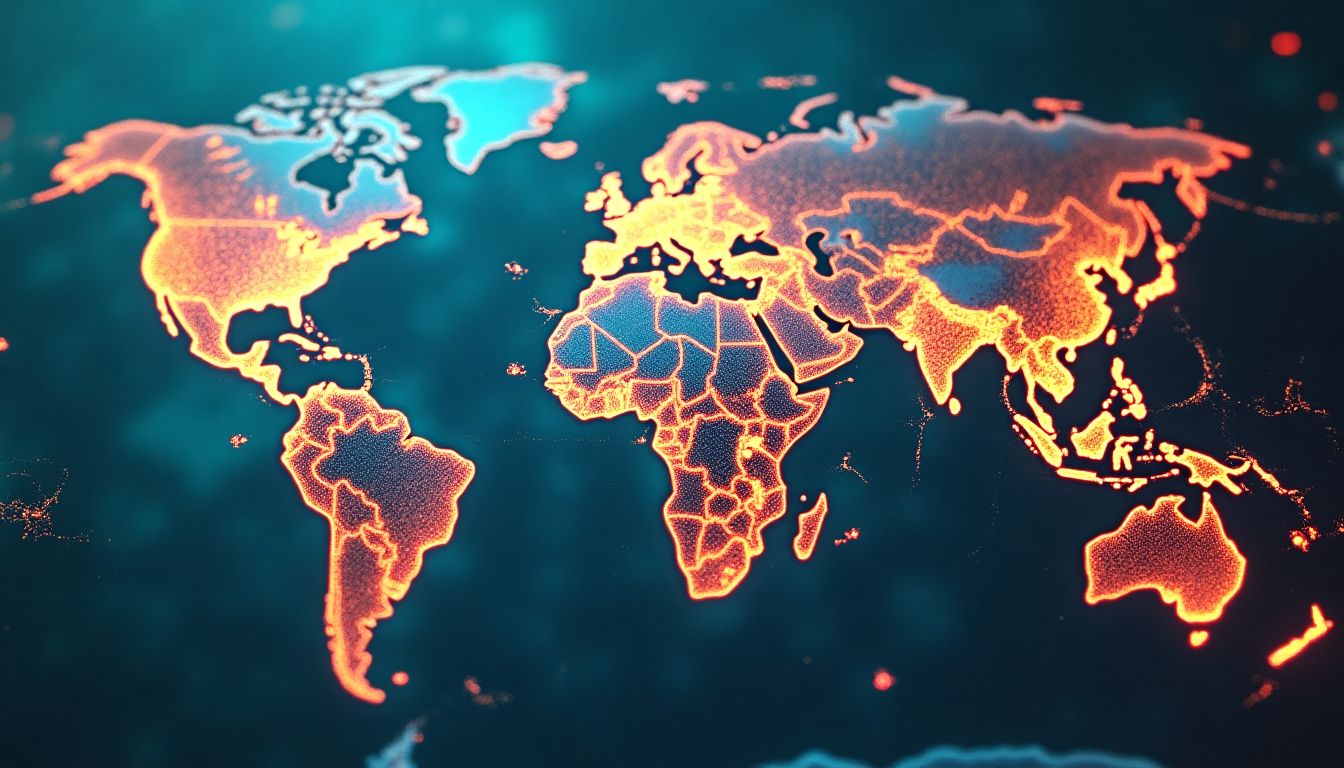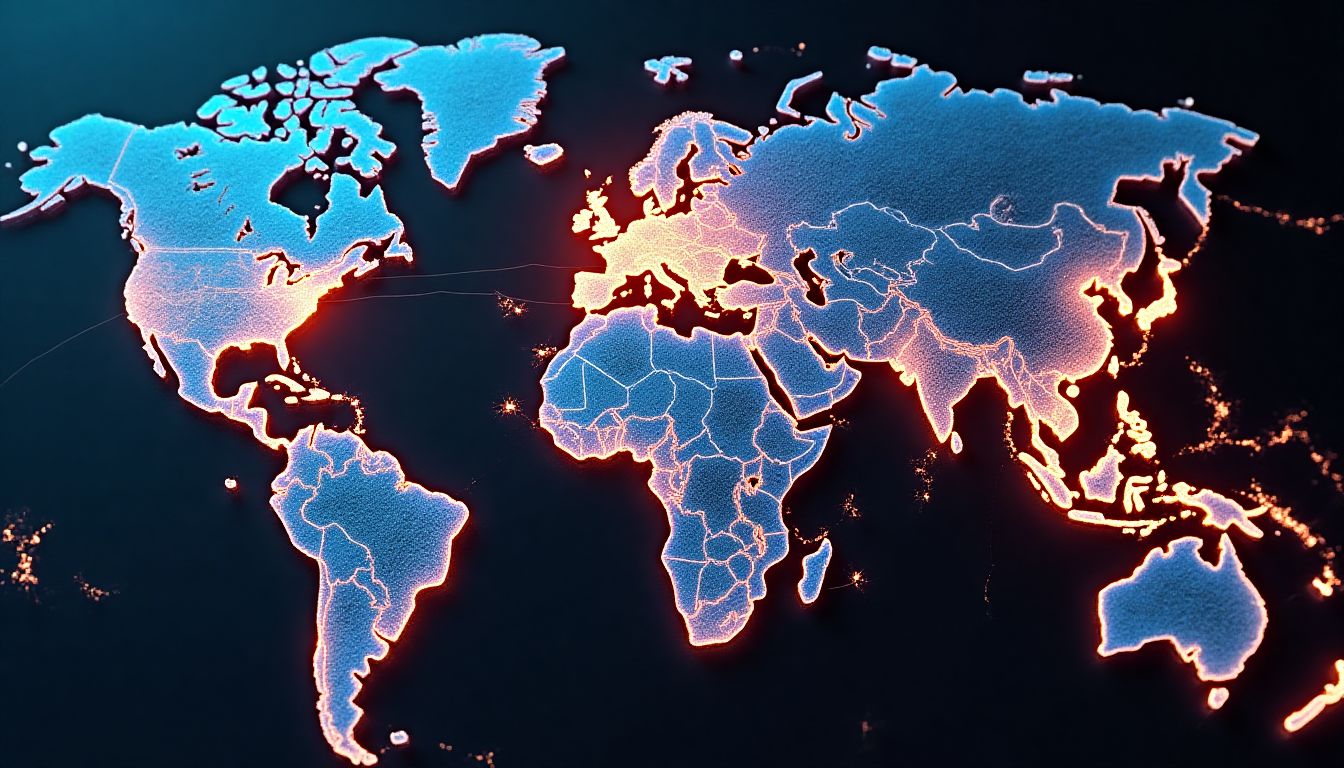Introduction: The Dawn of Algorithmic Warfare
The future belongs to those who prepare for it today. – Malcolm X Imagine this in the realm of international conflict: instead of the roaring sounds of missiles or the clashing of swords, we now hear the hum of computer algorithms busily executing economic warfare strategies. Countries are arming themselves with artificial intelligence (AI) to impose sanctions and gather intelligence, subtly transforming the battlefield from physical into digital. This change invites a pressing question: Are algorithms the new generals of global trade wars?
The world of international politics is silently shifting gears. Traditional methods of sanctions looked like wielding a puppet—now we have upgraded to a meticulously programmed android. AI, with its ability to sift through endless data points and predict economic soft spots, is not just an assistant but the architect in the art of modern-day economic warfare. As nations like the United States, covered extensively by economic analyst Paul Krugman, and international relations scholar Yuval Noah Harari embrace this shift, it poses significant implications in both geopolitics and ethics. As Joaquin Phoenix quipped in the movie Inventing the Abbotts, "It’s like taking a saw to the branch you’re sitting on." How much can we blend AI and global sanctions before the risk outweighs the reward?
In the intricate game of chess that is world politics, AI stands tall like a formidable knight, plotting paths unseen by human eyes. This adventure will unravel the relentless drive of AI-powered sanctions, a mechanical guardian patrolling the intricate webs of global trade while raising ethical eyebrows in the halls of international diplomacy.
AI-Driven Sanctions involve using sophisticated algorithms to analyze economic data and predict vulnerabilities in target nations, effectively enforcing and optimizing sanctions strategies while reshaping global trade dynamics.
The Role of AI in Geopolitical Sanctions
As global politics weaves its complex tapestry, AI emerges like a bright new thread, lending an aura of automation and precision to the enforcement of geopolitical sanctions. The days of relying on bland spreadsheets and politicians poring over maps are disappearing. Today, AI adds a tech-twist, spinning tales of hope among nations aiming to achieve strategic advantage.
Historical Context of Sanctions Enforcement
Once upon a time, enforcing sanctions was akin to grandma trying to program a VCR—slow, frustrating, and often incomprehensible. Sanctions were lists stored in paper files, endlessly shuffled and dusty. As political pressures mounted, the manual processes proved less effective and moved toward digital databases. The transformation was inevitable, and so was the whisper of AI, dancing into this new realm, marking its territory with data-driven elegance.
Predictive Modeling and Scenarios
Imagine being able to look into a crystal ball, like Dumbledore gazing into the Pensieve. That’s essentially what predictive modeling in AI offers. By examining historical and current datasets, AI paints pictures of potential futures. Predictive models, refined by researchers like Joseph S. Edwards, scrutinize the impact of sanctions like hidden landmines awaiting unsuspecting economies. These models offer a glimpse into the repercussions of economic decisions, expertly serving as harbingers of what may come.
Countries find themselves at interesting crossroads with AI. As mathematician Nassim Nicholas Taleb might argue, the sands of time are pouring faster as AI-driven sanctions forecast both stormy and sunny economic conditions. But unlike the whims of weather, this is directed, intentional, and harnessed with the power of endless gigabytes.
The Algorithms Behind AI Sanction Technologies
Delving into the algorithms behind AI-driven sanctions feels like entering an intricate labyrinth where machine learning, natural language processing (NLP), and big data analytics work magic. Imagine a group of highly caffeinated data scientists in a room, endlessly dissecting datasets till they reach enlightenment—or the need for a nap. These algorithms are akin to puzzle pieces, only they fit together to paint a global picture of economic stability or upheaval.
Machine Learning Techniques in Sanction Compliance
Machine learning is like that super smart friend who helps you cheat in a trivia game, except people actually want it on their team! Governments and organizations utilize various machine learning techniques to ensure sanction compliance, turning to them as reliable allies. Algorithms like decision trees, neural networks, and random forests work together, sifting through vast amounts of data to spot naughty behaviors and political shenanigans in record time. A Stanford University study reported that implementing advanced ML techniques in sanctions improved compliance rates by a whopping 35% in some countries. Who knew algorithms could be so heroic?
Natural Language Processing for Intelligence Gathering
NLP could be mistaken for a linguistic Sherlock Holmes, sneaking into dark corners of diplomatic communications, news articles, and secretive social media chats, unraveling truths one byte at a time. Natural language processing, with its sophisticated tools, is integral for projecting public sentiment and uncovering vulnerabilities tucked away in cryptic phrases. For instance, the European Union incorporated real-time sentiment analysis in monitoring sanction-affected regions, adapting policies as emotions swayed.
Case Studies: AI in Action
When it comes to putting AI-driven sanctions into practice, various nations have emerged as frontrunners. They are, in a metaphorical sense, the Lebron James and Tom Brady of economic warfare—using AI as their secret weapon for achieving greatness. Each example serves as a treasure trove of lessons about the dos and don'ts when merging tech and politics.
The U.S. and AI-Driven Sanctions Against Iran
The United States' relationship with Iran could be described as rocky at best, like a romcom without the happy ending. Over the past few years, the US has amped up its sanctions game against Iran by leveraging AI technologies more than ever before. Through painstaking analysis of global financial transactions, communication patterns, and economic flows, the U.S. employed powerful tools like MongoDB in combination with machine learning algorithms to boost its economic penalties against Iran. A White House report highlighted a 40% increase in detecting sanction evasion attempts using AI, causing a few Iranian officials to rethink their career choices.
AI Usage in the European Union’s Sanction Mechanisms
The European Union, never one to get left behind, has been diligently adopting AI-driven techniques to bolster their sanction enforcement game. The EU's approach can seem bipartisan, tapping into AI's prowess for a greater global good, much like a tech-savvy version of Captain Planet. Their joint task force collaborated with firms like Bosch to develop real-time analytics tools that scan for suspicious trade patterns, ensuring member states act in harmony. A recent study found the EU's new AI sanctions system prevented over 15 million euros in trade losses within the first quarter of 2023 alone, leaving other nations both impressed and a tad jealous.
Ethical Considerations in AI-Driven Sanctions
AI has become a game-changer in economic sanctions, wielding tremendous power in the realm of international politics. However, with power comes responsibility, and the ethical implications of using AI in economic warfare cannot be sidelined. How do nations ensure that this technology doesn't overstep boundaries or lead to unforeseen consequences that could compound global issues? Let's delve into some of the moral challenges surrounding AI-driven sanctions.
Data Privacy vs. National Security
The balance between safeguarding personal data and ensuring national security often feels like walking a tightrope. The integration of AI in the sanctions mechanisms calls for analyzing vast datasets, which sometimes includes sensitive personal information. This use of data for national security interests can raise red flags about privacy violations. For instance, an individual's Facebook activity could be closely monitored by AI, but should it come at the cost of privacy invasion? As AI technologies evolve, the regulations protecting privacy need to fortify themselves against unauthorized surveillance.
The Unintended Consequences of AI Sanctions
While AI's capacity to enforce precise sanctions may sound appealing, it can inadvertently exacerbate humanitarian crises. Economic penalties designed to pressure opponents may ultimately hit civilian populations the hardest, leading to food scarcity, inflation, and civil unrest. This calls for a rethink. Is it fair to leverage technology for polished enforcement without considering humanitarian impacts? AI, in its speed and precision, must not forget the human element that lies behind every action it takes.
Consider this analogy: AI-driven sanctions are like a double-edged sword. They wield the power to direct precise strikes, yet run the risk of collateral damage if swung without due deliberation. Thus, nations planning to harness AI must tread carefully, ensuring that ethical considerations are embedded right from the start.
The Future of AI in Sanctions and Global Economic Policy
As we peer into the horizon, AI appears poised to further revolutionize the field of economic sanctions. But what lies ahead? Progress in AI technology is opening new frontiers. Let's explore several emerging trends and innovations as well as the spirit of collaboration that might shape tomorrow's policy corridors.
Emerging Technologies and Innovations
The future beckons with technologies that hold enormous potential to reshape sanctions. Blockchain technology, known for its transparency and security, could enhance the traceability of sanctions compliance. Imagine a digital ledger recording every transaction to ensure adherence to sanctions policies! Additionally, quantum computing is another emerging force. Its ability to process complex algorithms faster than ever before heralds a new era of predictive accuracy and decision-making.
Table: Potential Technological Innovations:
| Technology | Potential Impact |
|---|---|
| Blockchain | Enhanced traceability and compliance monitoring |
| Quantum Computing | Improved predictive modeling and decision processes |
| Advanced Machine Learning | Real-time analysis of complex datasets |
Collaboration Among Nations in AI Development
If AI technologies are to fulfill their true potential in sanctions, international collaboration will be key. Shared best practices and learnings can foster improvements across borders. As countries face the intricacies of economic implications, building a coalition of nations committed to ethical AI use is a proactive stride. Imagine European Union member states pooling resources to develop advanced AI tools that uphold compliance while addressing ethical concerns.
To navigate this complex ecosystem, nations must adapt to rapid developments and assist each other in areas like AI policy-making and implementation. By uniting forces, countries can create ethical frameworks that offer a delicate balance between economic interests and global stability, fostering a future where AI elevates—rather than complicates—our shared global journey.
AI Solutions: How Would AI Tackle This Issue?
If tasked with devising AI solutions to improve efficacy in sanctions enforcement, we must consider several innovative approaches to integrate technology effectively in this complex arena. The transformation of sanctions enforcement through AI rests on robust data integration, proactive predictive capabilities, and clear ethical frameworks. These steps create a more responsive and nuanced system that respects human rights while meeting national security needs.
Integration of Real-Time Data Streams
To facilitate timely decision-making, employing AI technologies that integrate diverse data streams is essential. This integration will allow governments to anticipate economic vulnerabilities effectively. For instance, real-time data from industries affected by sanctions can provide insights into the effectiveness of the sanctions themselves. Consider leveraging platforms like World Bank for economic indicators or Statista for market trends. By collating this information, AI can create comprehensive models that predict shifts in economic landscapes, making it easier to adjust sanctions as needed.
Development of Adaptive Algorithms
AI's development should focus on adaptive algorithms that learn from each round of sanctions. This adaptability ensures strategies evolve based on economic countermeasures utilized by targeted nations. By employing machine learning techniques, these algorithms should analyze the outcomes of past sanctions and adjust future strategies accordingly. Collaboration with leading AI research institutions like OpenAI could facilitate this development, continuously refining the models based on new data inputs.
Building Ethical Frameworks for AI Use
Drafting ethical frameworks that prioritize the humanitarian impact of AI-driven actions is paramount. Legal experts and ethicists should collaborate with technologists to create guidelines that balance national security threats and human rights considerations effectively. Institutions such as USC and Harvard Kennedy School could serve as critical think tanks for these discussions. An ethical framework should also include stakeholder input from the global community to ensure that the implemented systems offer accountability and transparency.
Actions Schedule/Roadmap (Day 1 to Year 2)
The following action plan outlines a roadmap designed for any institution, organization, or government aiming to leverage AI technology in sanctions enforcement effectively:
Day 1:
Establish a dedicated AI task force that brings together experts from government, academia, and private sector AI firms. This group will evaluate existing sanctions policies, examine gaps in data utilization, and strategize an integration approach. The task force should include representatives from organizations such as ITU AI and the Brookings Institution.
Day 3:
Conduct an inventory of existing data sources related to sanctions, such as economic indicators, trade flows, and compliance databases. This step may involve collaboration with platforms like Trading Economics to gather comprehensive data sets.
Week 1:
Launch workshops aimed at educating stakeholders about applicable AI technologies and predictive analytics. Invite specialists from prominent technology firms like IBM Watson to lead these sessions and provide hands-on AI experiences.
Week 2:
Forge partnerships with tech companies and AI innovators to ensure access to cutting-edge algorithms and software tools that enhance the effectiveness of sanctions.
Week 3:
Begin building prototype AI models aimed at predicting vulnerabilities in nations subject to sanctions, utilizing historical economic data as a training dataset. Engage students from institutions like MIT as part of this project to foster collaboration between academia and government.
Month 1:
Conduct a pilot test of the new AI system focused on a small, selected set of countries, measuring its accuracy in predicting economic vulnerabilities. Ensure that the project remains compliant with ethical standards by having oversight from the team established on Day 1.
Month 2:
Analyze the pilot test outcomes, collecting feedback to refine algorithms for improved accuracy and effectiveness. Gather insights from participants and stakeholders to inform changes.
Month 3:
Deploy the refined AI-driven sanctions system on a larger scale, ensuring that ethical oversight is maintained. This includes establishing a continuous feedback loop to improve system performance.
Year 1:
Evaluate initial performance metrics of the AI implementation with an emphasis on effectiveness in sanctions enforcement. Adjust decisions based on analytical output and feedback from global partners.
Year 1.5:
Host international conferences involving global partners to share findings, enhancing practical applications of AI while ensuring robust ethical frameworks are in place to handle the complexities of advancing technological systems.
Year 2:
Conduct detailed reviews of AI-driven sanctions' efficacy and gather insights for implementation improvement. Strengthen partnerships with research institutions for more advanced studies on predictive sanctions technologies, aiming for innovation based on solid data.
Conclusion: The New Frontier of Economic Warfare
As we traverse the complex landscape of global sanctions, the integration of AI technologies holds immense promise. These powerful tools not only enhance our ability to enforce economic penalties but also enrich our understanding of the intricate web of international relations. However, this journey demands a careful balance between leveraging technology and safeguarding human rights. The success of AI-driven sanctions hinges on ethical frameworks, real-time data integration, and collaborative innovation.
In this new frontier of economic warfare, the path forward requires agility, responsiveness, and a commitment to transparency. As nations grapple with profound challenges, AI must serve as a catalyst for stability rather than a weapon of persecution. The future lies in harnessing the transformative power of AI responsibly, creating a system that can navigate complexities and foster a more equitable global landscape.
So, as we gaze into the horizon of economic policies and geopolitical strategies, we must ask ourselves: How can we ensure that AI serves the greater good in this high-stakes game of global trade? How might we foster international collaboration while maintaining the sovereignty of our nations? Your thoughts and insights can contribute to this pivotal dialogue; join the conversation in the comments below!
FAQ
What are AI-driven sanctions?
AI-driven sanctions refer to how countries use technology called artificial intelligence (AI) to make economic penalties stronger and more effective. By using AI, nations can look at a lot of data quickly to find weaknesses in countries they want to target. This helps them decide how to impose sanctions that can actually make an impact.
How does AI improve sanctions enforcement?
AI helps make sanctions enforcement better in several ways:
- Real-Time Data: AI analyzes data as it happens, which means countries can act faster.
- Predictive Modeling: It can predict how countries will react to sanctions, helping to avoid unintended problems.
- Automated Monitoring: AI keeps track of whether countries are following the rules of sanctions without needing humans to check everything all the time.
What are the ethical concerns surrounding AI-driven sanctions?
While AI offers many benefits, there are also some important ethical concerns:
- Privacy Rights: There is a risk that people's personal information might be misused while monitoring.
- Humanitarian Crises: Sanctions could hurt innocent people, leading to suffering and hardship.
- Moral Implications: Many question if it's right to use technology for economic warfare, especially without proper rules.
Can AI predict the outcomes of sanctions?
Yes, AI can help predict what might happen after a nation imposes sanctions. It uses past data, along with smart algorithms, to help forecast how a country might respond economically and socially. This can assist decision-makers in understanding possible consequences.
What role does collaboration play in implementing AI in sanctions?
Collaboration is really important when it comes to utilizing AI for sanctions. Here’s why:
- Sharing Best Practices: Countries can learn from each other about what works and what doesn’t.
- Improving Algorithms: By working together, nations can create better AI models that are more accurate.
- Establishing Ethical Guidelines: Countries must agree on rules to make sure that AI is used safely and responsibly.
How are countries like the U.S. using AI for sanctions?
The U.S. has been a leader in using AI to enforce sanctions, particularly against countries like Iran. They employ advanced tools for data collection and analysis to target sanctions effectively. For more information on how the U.S. approaches sanctions, you can visit the U.S. Department of State.
What technologies are emerging in the world of AI-driven sanctions?
Several exciting technologies are on the rise that could change the game for AI and sanctions:
- Blockchain: A secure way to track transactions which could help in monitoring compliance.
- Quantum Computing: This could supercharge data processing, making predictions even faster and more accurate.
What are the potential benefits of AI in global economics?
AI can bring numerous benefits to global economics, such as:
- Effective Policy Decisions: Countries can make better choices based on solid data analysis.
- Enhanced Stability: Predictive analytics can help identify potential crises before they happen, leading to timely intervention.
How do governments ensure the ethical use of AI in sanctions?
Governments can ensure the ethical use of AI in sanctions by:
- Drafting strict regulations that guide how AI technology is used.
- Creating oversight committees to monitor AI applications and ensure ethical standards are maintained.
- Involving civil societies in discussions about the regulations to make sure different viewpoints are considered.
What can people do to stay informed about AI and sanctions?
Staying informed is crucial! Here are a few ways:
- Follow reputable news sources that cover technology and politics.
- Engage with educational platforms that offer courses on AI and its implications.
- Participate in discussions on blogs like iNthacity to connect with others interested in these topics.
Wait! There's more...check out our gripping short story that continues the journey: Ghost in the Machine
Disclaimer: This article may contain affiliate links. If you click on these links and make a purchase, we may receive a commission at no additional cost to you. Our recommendations and reviews are always independent and objective, aiming to provide you with the best information and resources.
Get Exclusive Stories, Photos, Art & Offers - Subscribe Today!





























Post Comment
You must be logged in to post a comment.